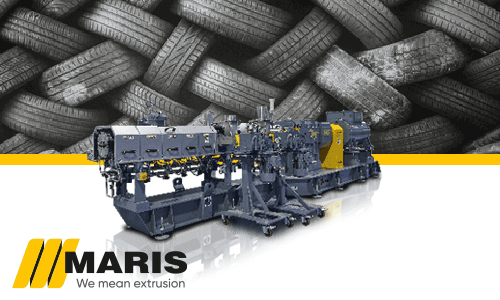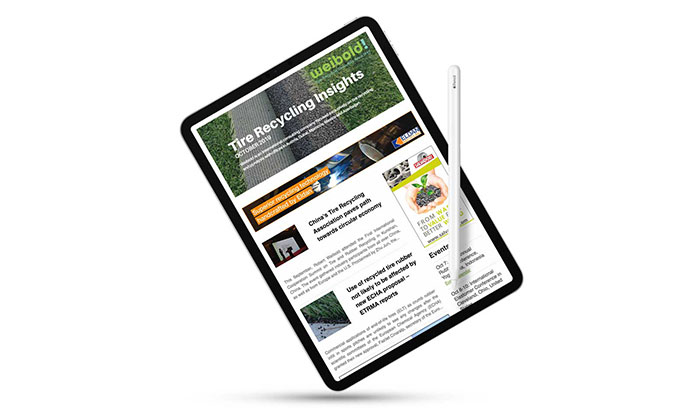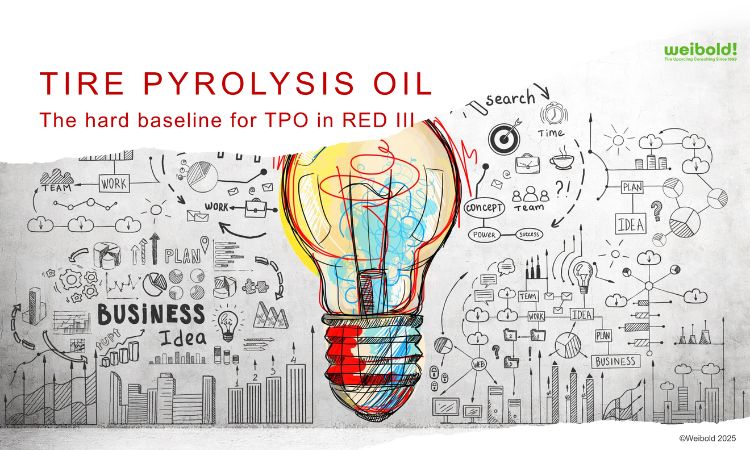Weibold Academy: From 9.1% to 6.9% – the world is becoming less circular
Weibold Academy article series discusses periodically the practical developments and scientific research findings in the end-of-life tire (ELT) recycling and pyrolysis industry.

These articles are reviews by Claus Lamer – the senior pyrolysis consultant at Weibold. The reviews aim to give industry entrepreneurs, project initiators, investors, and the public a better insight into a rapidly growing circular economy. At the same time, this article series should stimulate discussion.
For completeness, we would like to emphasize that these articles are no legal advice from Weibold or the author. Please refer to the responsible authorities and specialist lawyers for legally binding statements.
A Shrinking Circle: The Story of a World Consuming Too Much
In 2018, the world took its first objective measure of our economy's circularity. The result, 9.1%, was already sobering. Just over nine percent of all materials consumed by the global economy were being recycled and reintroduced. The remaining ninety percent ended as waste or emissions or locked away in long-lived assets like buildings and infrastructure. Since then, the situation has only worsened despite the circular economy becoming popular in global sustainability dialogues.
According to the Circularity Gap Reports (CGRs) of 2023, 2024, and 2025, the global economy is becoming progressively less circular. By 2023, the Circularity Metric had dropped to 7.2%; by 2025, it had slipped further to just 6.9%. In a time of intensifying climate, biodiversity, and pollution crises, this steady decline is not just alarming, it’s a call to rethink how we produce, consume, and discard fundamentally.
The Current Picture: A System Stretched to Its Limits
The 2025 Circularity Gap Report paints a detailed picture of a planet under pressure. Each year, humanity extracts over 100 billion tons of materials, which is projected to grow by another 60% by 2060 if current trends continue. While recycling has modestly increased in absolute terms, from 7.1 to 7.3 billion tons since 2018, the overall percentage of secondary material use continues to decline. Why? Because virgin material consumption is growing even faster.
Of all materials flowing through the global economy in 2025, less than 7% are recycled. More than a third are locked in stock: new buildings, roads, and machines that won't be reused for decades. Meanwhile, nearly 20% of materials are virgin non-renewables that could theoretically be recycled but currently are not. Fossil fuels still comprise over 13% of material inputs and remain the primary global source of greenhouse gas emissions. Biomass extraction, while renewable in theory, continues to drive deforestation and biodiversity loss, as its cultivation increasingly disregards ecological thresholds.
Past and Present: A Decade of Decline
The pattern is clear if we zoom out and look at the trajectory over the last three reports. In 2018, 9.1% of global material inputs were circular. By 2023, this had dropped to 7.2%. One year later, it stagnated. And in 2025, it fell again to 6.9%.
This trend is especially striking when considering the global momentum, the circular economy has gained in policy and business circles. Nations like Japan and the Netherlands have outlined national circular economy strategies, and corporate commitments have proliferated. Yet, the data points in the opposite direction.
The reasons are structural. High-income countries—referred to in the reports as “Shift” countries—continue to consume vastly more than their fair share. While home to just 17% of the global population, these nations consume 25% of raw materials and are responsible for 43% of global emissions. Middle-income “Grow” countries like China, Indonesia, and Brazil are rapidly industrializing, producing booming material consumption. Meanwhile, many low-income “Build” African and Southeast Asian countries must still increase their material use to meet basic human needs.
Why the Circle Shrinks: A Commentary on Systemic Challenges
So why does global circularity keep falling despite growing awareness and numerous initiatives?
One key reason lies in the scale and structure of the global economy. Material extraction and economic growth remain tightly coupled, especially in middle-income countries trying to raise living standards. Even in high-income countries, infrastructure and consumption patterns are deeply embedded in linear logic, designed for efficiency, not circularity.
Moreover, recycling alone cannot keep pace. The quantity of extracted virgin materials is growing faster than recycling systems can adapt. Infrastructural materials—concrete, asphalt, and steel—are used in volumes too massive to be offset through traditional recycling. Many consumer products, especially electronics and textiles, are complex and not designed for disassembly or reuse. In addition, the absence of binding global targets on material use results in a circularity system overwhelmed by volume.
However, perhaps the most critical barrier is cultural and political inertia. Governments still heavily subsidize fossil fuels, and wasteful consumption is often seen as a sign of prosperity. While many corporations innovate at the margins, few are ready to rethink their business models fundamentally.
Hope in Systems Thinking: A Roadmap Forward
Despite the bleak statistics, the reports are not without hope. All three reports emphasize a systems-based vision of circularity, going beyond recycling to embrace four guiding principles:
- Use Less: Reduce demand for new materials by redesigning how we meet needs, such as through sharing platforms, modular buildings, and public transport.
- Use Longer: Extend product lifespans via repair, maintenance, and reuse.
- Use Again: Improve material recovery and recycling where possible.
- Make Clean: Transition from fossil-based to renewable inputs and energy, eliminating toxic substances.
A Role for Technology: Unlocking Circularity through Chemical Recycling
While much of the circular economy discourse emphasizes sufficiency and regenerative design, technology still plays a critical role, especially in dealing with legacy waste. One field that holds tangible promise is chemical recycling, particularly for complex waste streams that mechanical methods cannot effectively address, like end-of-life tires (ELT), mixed plastics, and technical textiles.
Chemical recycling involves pyrolysis, gasification, and solvolysis, breaking materials into their molecular components, enabling them to be reused as high-quality feedstock. Unlike mechanical recycling, which often results in lower-quality materials, these advanced methods can produce outputs comparable to virgin materials.
A particularly promising application is the treatment of end-of-life tires (ELTs). Over one billion tyres are discarded globally each year, often incinerated or end up in landfills. Through chemical processes like pyrolysis, these tires can be transformed into carbon black, pyrolysis oil, synthetic gas, and recovered steel, which can be reintroduced into the economy in sectors ranging from automotive to construction. This closes the loop on one of the most challenging waste streams, reducing environmental impact and dependency on fossil-based virgin materials.
The Circularity Gap Report 2025 highlights that around 18% of all global material inputs consist of virgin materials that are currently unrecovered and represent untapped circular potential, a gap that chemical recycling could help bridge. If this fraction of unrecovered material were fully recycled, the Circularity Metric could increase from 6.9% to approximately 25%, assuming no changes in total material throughput. When powered by recycled and cleaned process gases (energy self-sufficiently), renewable energy, and paired with quality standards, chemical recycling can raise the Circularity Metric significantly and offer a viable path to dealing with stubborn, linear material flows.
Of course, safeguards are essential. Chemical recycling must be tightly regulated to ensure that outputs are circular and not merely used as fuel. However, when applied strategically, especially in high-volume sectors like tires, it can become a key enabler of circular industrial transformation, rather than a distraction from sufficiency.
Conclusion: Tools in Hand, Time to Act
The circular economy is not a quick fix. It is a long-term redesign of our economic metabolism that asks us to look beyond symptoms and address the deeper structures of how we extract, produce, consume, and discard. Today, the world remains trapped in a take-make-waste model, which is profitable in the short term but devastating for planetary systems and long-term prosperity.
The last three Circularity Gap Reports leave no room for denial: global circularity is shrinking. But they also offer something more important than data: directions. We know the principles that work: use less, use longer, use again, and make clean. We know circularity is about recycling bottles and reimagining systems—from cities and food supply chains to product design and infrastructure.
The reports show that technology can be a powerful ally when purposefully applied. Chemical recycling, particularly for hard-to-treat waste like end-of-life tires, demonstrates that innovation has a place in the circular future, not as a loophole, but as a catalyst for real progress. Technologies like pyrolysis can help to recover valuable materials, reduce dependency on virgin resources, and keep otherwise unrecoverable waste within the loop. If integrated thoughtfully and governed responsibly, such innovations could help reverse the trend of declining circularity.
We stand at a crossroads: either we continue down a linear path of growing extraction and shrinking resilience, or we begin to build a circular economy that is smarter, fairer, and more robust. It’s not too late to turn the shrinking circle into a growing spiral of regeneration.
We need bold action, intelligent regulation, and radical collaboration between industries, governments, innovators, and citizens. The tools are in our hands, the science is clear, and the story of circularity is still being written.
Sources:
Circle Economy. (2025). The circularity gap report 2025. Amsterdam: Circle Economy.
Circle Economy. (2024). The circularity gap report 2024. Amsterdam: Circle Economy.
Circle Economy. (2023). The circularity gap report 2023. Amsterdam: Circle Economy.
These reports are licensed under a Creative Commons Attribution-ShareAlike 4.0 International License.
Weibold is an international consulting company specializing exclusively in end-of-life tire recycling and pyrolysis. Since 1999, we have helped companies grow and build profitable businesses.











